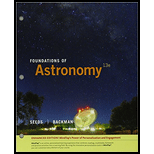
Identify the object in the solar system.
Answer to Problem 1RQ
The object described here is a meteoroid.
Explanation of Solution
A meteoroid is nothing but is a piece of stone debris move through the space. This may have found in large or smaller size. Some of the smallest meteoroid comes from the moon or mars and largest meteoroid assumed to be comes from the asteroid belt. Meteoroids also will come to the earth’s atmosphere and it will start to glow because of the attrition.
Meteoroids can also make big impact on the planets as well as different moon surfaces. Most of the meteoroids are larger than a pebble and are rocky. These are also the part of Solar system. When these are enter into the earth’s atmosphere and some part is survived form the friction, the leftover part is known as meteorite.
Conclusion:
Therefore, the object described here is a meteoroid.
Want to see more full solutions like this?
Chapter 25 Solutions
Bundle: Foundations of Astronomy, Enhanced, Loose-Leaf Version, 13th + MindTap Astronomy, 2 terms (12 months) Printed Access Card
- How do you draw a diagram of the ruler and mass system in equilibrium identifying the anti-clockwise torque and clockwise torque? How do I calculate the anti-clockwise torque and the clockwise torque of the system with the ruler and the washers, does it come from the data in table 4? Please help, thank you!arrow_forwardExample Double pane windows have two panes of glass (n = 1.5), with a layer of air sandwiched between them. If light from outside enters the first pane at an angle of 25° from the surface normal, what angle does it enter the house at? ☑ 3 5arrow_forwardDid your experiment results in Data Table 3 verify, to within a reasonable experimental error, the condition of equilibrium of Equation 6: Στanti-clockwise = Στclockwise? Support your response with experimental data. What does this Σ mean? My results do not show they are equal to each other, what does this mean then, and what does the data show? Thanks!arrow_forward
- An object is placed 37.4cm in front of a diverging lens with a focal length of 18.1 cm. Please provide your answers in units of cm if necessary. bookmark_border1.0p3a Find the image distance. Answer Updated 6 days ago Show feedback bookmark_border1.0p3b Is the image real or virtual? Real Virtual Updated 6 days ago Show feedback bookmark_border1.0p3c Suppose the object is brought to a distance of 10.3 cm in front of the lens. Where is the image now with respect to its previous location? (Note: Ensure the sign convention you use is consistent by treating all image distances on the object side of the lens as negative.) Answer Updated 7 minutes ago Show feedback bookmark_border1.0p3d How has the height of the image changed if the object is 84.2 cm tall? Answerarrow_forwardn object is placed 37.4cm in front of a diverging lens with a focal length of 18.1 cm. Please provide your answers in units of cm if necessary. bookmark_border1.0p3a Find the image distance. Answer Updated 6 days ago Show feedback bookmark_border1.0p3b Is the image real or virtual? Real Virtual Updated 6 days ago Show feedback bookmark_border1.0p3c Suppose the object is brought to a distance of 10.3 cm in front of the lens. Where is the image now with respect to its previous location? (Note: Ensure the sign convention you use is consistent by treating all image distances on the object side of the lens as negative.) Answer Updated just now Show feedback bookmark_border1.0p3d How has the height of the image changed if the object is 84.2 cm tall? Answerarrow_forwardCan you draw a FBD and KD please!arrow_forward

 Physics for Scientists and Engineers: Foundations...PhysicsISBN:9781133939146Author:Katz, Debora M.Publisher:Cengage Learning
Physics for Scientists and Engineers: Foundations...PhysicsISBN:9781133939146Author:Katz, Debora M.Publisher:Cengage Learning Principles of Physics: A Calculus-Based TextPhysicsISBN:9781133104261Author:Raymond A. Serway, John W. JewettPublisher:Cengage Learning
Principles of Physics: A Calculus-Based TextPhysicsISBN:9781133104261Author:Raymond A. Serway, John W. JewettPublisher:Cengage Learning Foundations of Astronomy (MindTap Course List)PhysicsISBN:9781337399920Author:Michael A. Seeds, Dana BackmanPublisher:Cengage Learning
Foundations of Astronomy (MindTap Course List)PhysicsISBN:9781337399920Author:Michael A. Seeds, Dana BackmanPublisher:Cengage Learning
 Glencoe Physics: Principles and Problems, Student...PhysicsISBN:9780078807213Author:Paul W. ZitzewitzPublisher:Glencoe/McGraw-Hill
Glencoe Physics: Principles and Problems, Student...PhysicsISBN:9780078807213Author:Paul W. ZitzewitzPublisher:Glencoe/McGraw-Hill





